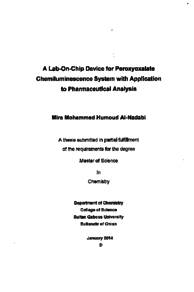Document
A lab-on-chip device for peroxyoxalate chemiluminescence system with application to pharmaceutical analysis.
Publisher
Sultan Qaboos University
Gregorian
2014
Language
English
Subject
English abstract
Microfluidic device or a lab on a chip has been explored as a tool for the development of a highly sensitive, fast and economic method for analysis of tranexamic acid (TA) and amlodipine besylate (AM) in pharmaceutical formulation through peroxyoxalate chemiluminescence (PO-CL) reaction. This reaction involves the oxidation of an oxalic acid derivative by hydrogen peroxide in the presence of a suitable fluorophore such as fluorascamine (FA). Where FA was reacted with TAJAM and the derivatization product (FA-TA or FA-AM) was used in bis-(2,4,6-trichlorophenyl) oxalate (TCPO-CL) system. The parameters that affect the CL signal intensity were carefully optimized. These include pH, concentration of reagents used, the flow rates and instrumental setup. Also, the effect of imidazole, commonly used as a catalyst in PO-CL system was extensively investigated and the effect of different surfactants in CL signal intensity.
A linear range calibration curve between (5-900 ng mL-?) and (10-100 ng ml") was achieved under optimum conditions for TA and AM respectively. The Limit of detection (LOD) was found to be 1 ng mL-1 for TA while for AM its equal to 3 ng mL-'. Also the limit of quantification (LOQ) was 3 ng ml.* and 10 ng mL-' for TA and AM respectively. This method was found to be fast as it takes less than 120 runs per hour to be carried out and economically good consuming only 0.3 ug of FA and 2.5 ug of TCPO per run. Finally, the method was practical for analysis of TA and AM in pharmaceutical product with a nearly 100% recovery
CL signal intensity from other interfering ingredients normally present in these products.
Member of
Resource URL
Arabic abstract
قد تم دراسة جهاز الميكروفلويديك أو نظام مختبر على رقاقة أحادية الشريحة كأداة لتطوير طريقة سريعة واقتصادية وحساسة للغاية بهدف تحليل حمض الترانيكساميك والأملوديبين بيزيلات في التركيبة الدوائية من خلال تحفيز اللمعان الكيميائي للبيروأكسالات كردة فعل. ويشمل هذا التفاعل اكسدة مشتقات حمض الأكساليك بواسطة بيروكسيد الهيدروجين في وجود الفلورواسکامین. حيثما يتفاعل الفلورواستامين مع حمض الترانيكساميك أو الأملوديبين بيزيلات، فإن المشتقات يتم استخدامها في نظام الكلوروفينيل الثلاثي المكرر. ويتم تحسين العوامل التي تؤثر على كثافة إشارة اللمعان الكيميائي بعناية. وهذه العوامل تشمل الحموضة، وتركيز الكواشف المستخدمة، ومعدلات التدفق وإعدادات الأجهزة. كذلك تأثير الإيميدازول والتي يشيع استخدامها كعامل محفز في هذا النظام وتأثير انواع مختلفة لخافض التوتر السطحي كثافة إشارة اللمعان الكيميائي.
وقد تم تحقيق منحني معايرة خطي بين ( 5-900 نانوغرام مل) و( 10-100 نانوغرام مل) تحت الظروف المثلي الحمض النترانيكساميك و الأملوديين بيزيلات، على التوالي. وقد كان الحد الأدنى للكشف 1 نانوغرام مل لحمض الترانيكساميك وتقريبا 3 نانوغرام ملا ل الأملوديبين بيزيلات. كما كان حد القياس الكمي 3 نانوغرام ملا لحمض الترانيكساميك و 10 نانوغرام مل ل الأملوديبين بيزيلات. وقد وجد بين هذه الطريقة سريعة لأن تنفيذها يستغرق أقل من 120 جولة في الساعة، كما أنها جيدة اقتصاديا حيث يتم استهلاك فقط 0 . 3 مايكروغرام ملا من حمض الترانيكساميك و2 . 5 مايكروغرام ملا من الأملوديبين بيزيلات في كل جولة. أخيرا، كانت هذه الطريقة عملية في تحليل حمض الترانيكساميك والأملوديبين بيزيلات في المنتجات الدوائية مع استرداد يقارب ال 100 ٪ الكثافة اللمعان الكيميائي من غير التداخل مابين المكونات الأخرى الموجودة في هذه المنتجات والمركب المراد تحليله.
وقد تم تحقيق منحني معايرة خطي بين ( 5-900 نانوغرام مل) و( 10-100 نانوغرام مل) تحت الظروف المثلي الحمض النترانيكساميك و الأملوديين بيزيلات، على التوالي. وقد كان الحد الأدنى للكشف 1 نانوغرام مل لحمض الترانيكساميك وتقريبا 3 نانوغرام ملا ل الأملوديبين بيزيلات. كما كان حد القياس الكمي 3 نانوغرام ملا لحمض الترانيكساميك و 10 نانوغرام مل ل الأملوديبين بيزيلات. وقد وجد بين هذه الطريقة سريعة لأن تنفيذها يستغرق أقل من 120 جولة في الساعة، كما أنها جيدة اقتصاديا حيث يتم استهلاك فقط 0 . 3 مايكروغرام ملا من حمض الترانيكساميك و2 . 5 مايكروغرام ملا من الأملوديبين بيزيلات في كل جولة. أخيرا، كانت هذه الطريقة عملية في تحليل حمض الترانيكساميك والأملوديبين بيزيلات في المنتجات الدوائية مع استرداد يقارب ال 100 ٪ الكثافة اللمعان الكيميائي من غير التداخل مابين المكونات الأخرى الموجودة في هذه المنتجات والمركب المراد تحليله.
Category
Theses and Dissertations

